About Western Optical
Why we're loyal to YOU.
The business philosophy and personal story behind Western Optical Supply.
By Joshua Freilich
President and Founder
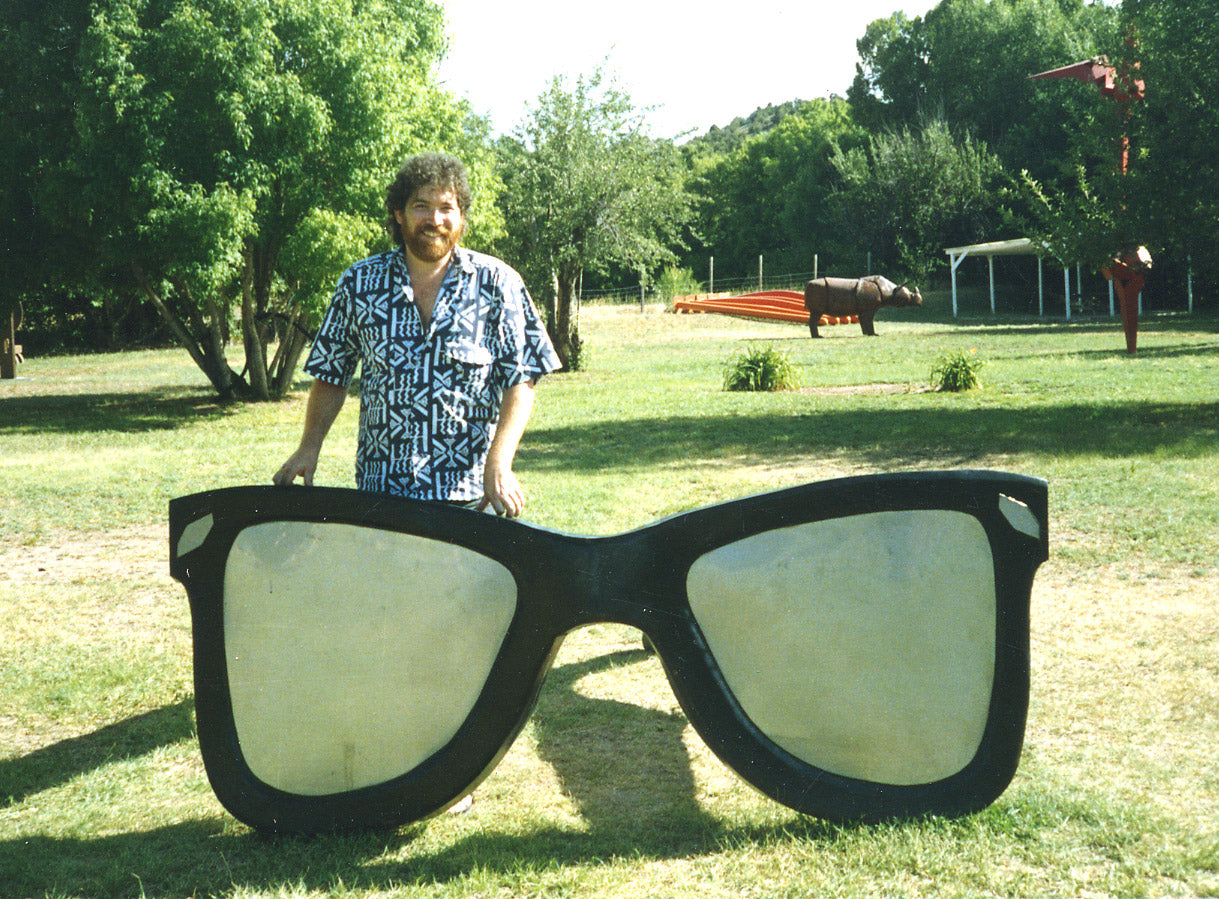
Joshua always had a grand vision for what could be done in the optical field.
Way back in 1974, I founded Western Optical Supply, Inc. Our industry has changed a lot since then, yet it remains an exciting blend of wonderful people, science, and craftsmanship. We continue to work diligently for you, contributing to a brighter future for eye care professionals and keeping to our founding principles.
You put the roof over our head, and the food on our table.
Western Optical keeps it personal. I insist that Western Optical be an independent corporation practicing the Golden Rule. We treat you the way we wish to be treated. We want to know how we can contribute to making your business more successful. Only when you succeed, will we succeed.
Innovation, Quality and Value are important to us.
To guarantee you high quality products, Western owns the factories that manufacture our tools in the USA and Pakistan. This gives us total control over the entire process from design through production to distribution. It also enables us to offer you our superior products at very affordable prices.
We provide superior working conditions and pay a living wage in our factories. We want our workers to care about the products they make for you and to feel good about the USA.
Western actively designs new products so you are the first to get labor-saving eyewear adjusting tools. We compete for your patronage by offering you innovative, quality products at value pricing.
Western Optical is not owned by an investment bank or a mega corporation whose motivation is to maximize their return on investment. Our competitors operate differently than we do. Their line expansion is often done through copying the designs of others and producing an inferior, cheaply made product. I believe that there is no integrity in appropriating another company's product design and pursuit of profit is not a justifiable rationalization for doing so.
In a never-ending search for the lowest cost product, our competitors change sources frequently and have no control over fabrication. Their vendors often use sub-contractors so the actual manufacturer is unknown, as are the quality control and working conditions. Replacement parts don't fit properly or are totally unavailable.
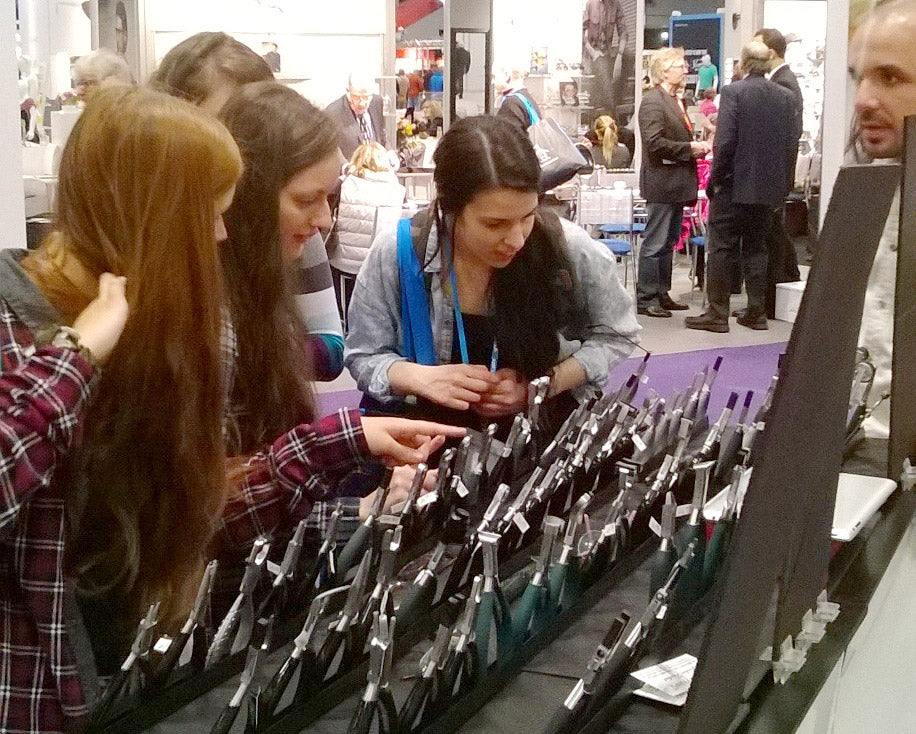
Fans checking out our products at the 2014 Vision Expo
We love Chinese food but...
Less than 1% of our product line is manufactured in China. Compare our track record to our competition. Those few items that we do source in China are world-class with quality and features comparable to the best products made anywhere else.
Our competitors' practice of sourcing products on the basis of low price pressures their vendors to make cheaper and cheaper goods. You pay a high price when attempting to operate a business successfully with inferior products. It is against our philosophy to sacrifice quality, value and customer service for profit.
We'll never phone to badger you for an order.
Just as I hate being interrupted by phone solicitors, we'll never call you to generate a sale. We eagerly wait for you to call us or use our website, when it is convenient for you.
In the pressure to meet sales quotas, our competitor's commissioned salespersons work the phones to enrich themselves at the expense of your time and money. Worst of all, you're paying extra for this "service." Compare prices and you'll be doubly incensed.
If you love me, show me...
Sometimes innovation, value, great customer service, and an intuitive website with educational videos is just not enough. You want something more you can count on...or actually, count out...like real money. We earn your patronage when you keep more of what you earn when buying Western products. Sign up for our exclusive "Be The First To Know" internet announcements on our home page. We really do appreciate you!
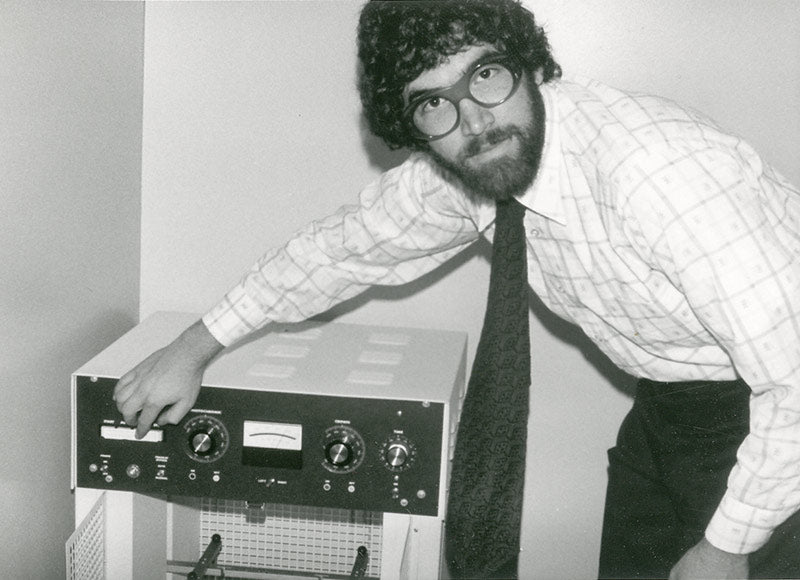
Joshua servicing chemical hardener equipment in 1975
The Story of Western Optical Supply
I would like to share the historical perspective that drives the Western Optical brand. In 1970, I worked as assistant to Dr. Ezra Novak, founder of Novamatic Systems. This manufacturing corporation taught me that only quality products guaranteed long term customer satisfaction. Every product we made was durable as well as economical.
Novamatic Systems distributed the first diamond wheel edger made in the USA by Lemay Corporation, under the leadership of Emil Santinelli. The Lemay Robot literally brought edging out of the stone ages. Edging lenses went from a 45+ minute process to 90 seconds. Mr. Santinelli hired me to oversee their California office, spearhead marketing and write technical manuals. Lemay produced almost every component of their machines, which included manufacturing their own diamond wheels. Experiencing the process from concept to finished product was inspiring. If you can think it, you can make it.
Before the days of 800 numbers and convenient delivery services, I started Western Optical Supply as a West Coast distributor of bench products. We had several thousand clients, the majority of whom I knew personally. But as a distributor, I understood that we would always be subject to the whims of a manufacturer. The desire to control quality, supply and innovation drove me to start manufacturing.
My opportunity arrived when Western Optical Supply acquired a company called, Optigraphics. Ahead of its time in designing and fabricating unique eyewear displays, the Optigraphics line ranged from small displays for single frames to large freestanding pieces of solid walnut furniture.
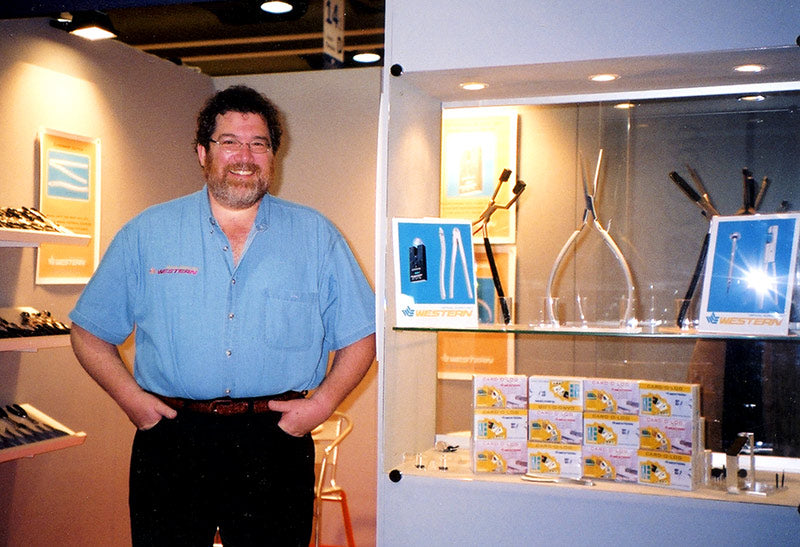
Joshua, at Western Optical's MIDO Booth in 2004
We took the line and expanded the designs to provide displays throughout the USA. Today, that lineage extends to our Western-Eyes line of eyewear displays and dispensing room accessories.
During this period in early 1970, I had the privilege of associating with men who loved and honored the craft of the optician. They came from the "old school" where you would apprentice to acquire skills. Gerd Oppenheim (founder Optical Machinery International), Roy Marks (consultant) and Marty Topaz (publisher Optical Index) were particularly significant.
These men instilled me with the conviction that your product must enhance and supplement the skills of the optician and the quality of a product was a direct reflection of your personal integrity.
None of them put walls between themselves and their clients. They, personally, attended trade shows and directly answered the phone. Their behavior strongly influenced my decision to remain in constant communication with you, providing personal attention.
In a world of impersonal customer service and detached corporate managers, I encourage your suggestions so that Western can continue to provide innovative products that address your personal needs. This is another reason why, nearly three decades ago, we invested in our own factory in Sialkot, Pakistan.
While our competitors use a variety of vendors to create a product line, Western provides you with one reliable source bringing you labor saving tools years before our competition can offer inferior knockoffs. Overseas manufacturers ignore intellectual property rights (patents and copyrights) while low price is promoted over quality.
As a Western Optical Supply customer you have had access to a Rimless Compression Plier years before it was offered by our competition. The Universal Nut Grabber is another amazing exclusive innovation. The list goes back over four decades of offering tools that expedite the repair and adjustment of eyewear allowing you to have more time to serve your patients.
I hope this brief overview of the influences that aided me in shaping our corporate philosophy gives you security in knowing that you can depend on a Western Optical Supply product to be quality built and right for the task.
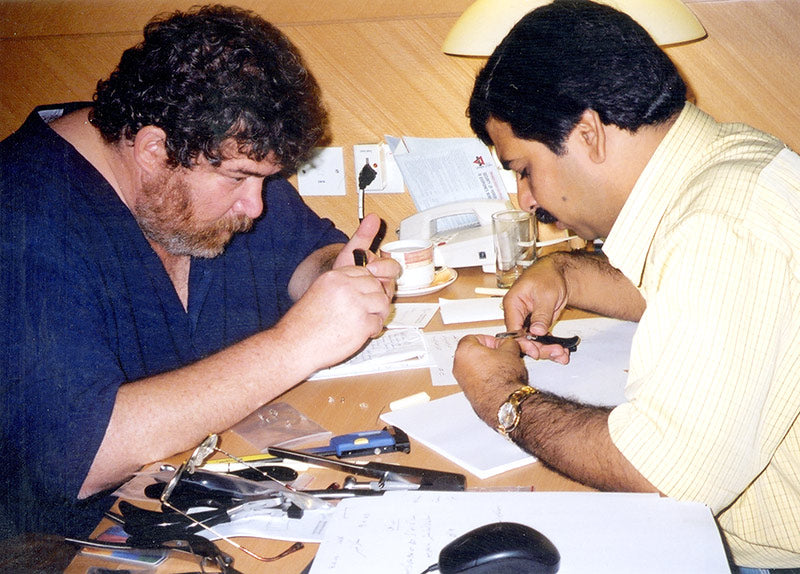
Designing new tools with our Pakistan facility Director in Hong Kong, 2003
The Legend of Joshua Freilich (sung to the tune of...)
You might be wondering how a fellow devotes most of his professional life to designing and manufacturing hand tools for the dispensing ECP. Glad you asked.
I was born in 1951 in Manhattan, New York City. As a kid, I considered it to be a golden age in the most interesting city in America. I appreciated it even then as I was riding the subways or playing hooky from school in the Cloisters museum.
My neighborhood was Washington Heights which in many ways resembled a small village within the larger metropolis. Back in the 1950s, the inhabitants were mostly immigrants who had survived WWII and Washington Heights was the second step up the ladder of the American dream.
New York City, at the time, was an industrial hub. All those high rises and skyscrapers held mostly factories and showrooms. The adults I knew were involved in manufacturing, mostly as laborers but some had brought skills from overseas and had already worked their way into management positions.
I attended public school while my Irish friends attended Catholic School. We often debated which was worse. They usually won. Jewish kids, like me, did double duty, however: a day at public school, then several hours in religious studies. I had an additional level of engagement as an active Boy Scout. It was all calculated to allow us little free time for hanging out on the streets waiting for parents to return after work.
The school system was designed to crank out workers for the factories. There was lots of discipline, memorization, homework and mixing of ethnic groups. It was a clean, safe and interestingly diverse neighborhood.
There wasn't much class distinction in Washington Heights. Basically, everyone had come from somewhere else and had started from zero. My father worked in a sweatshop in the Lower East Side sewing neckties. My mom worked in the neighborhood as a seamstress so she could be near home and her children.
Both worked six days a week and I never recall either having a bad word to say about their employment. Well or sick, in good weather or bad, my dad left the apartment in a white shirt, necktie and sports coat at 6:50 every morning. We were all at the kitchen table when he returned at 6:50 at night. My mom would walk us to school and be home shortly after 5 to start her second job as homemaker. My childhood environment gripped me with a work ethic that never let go.
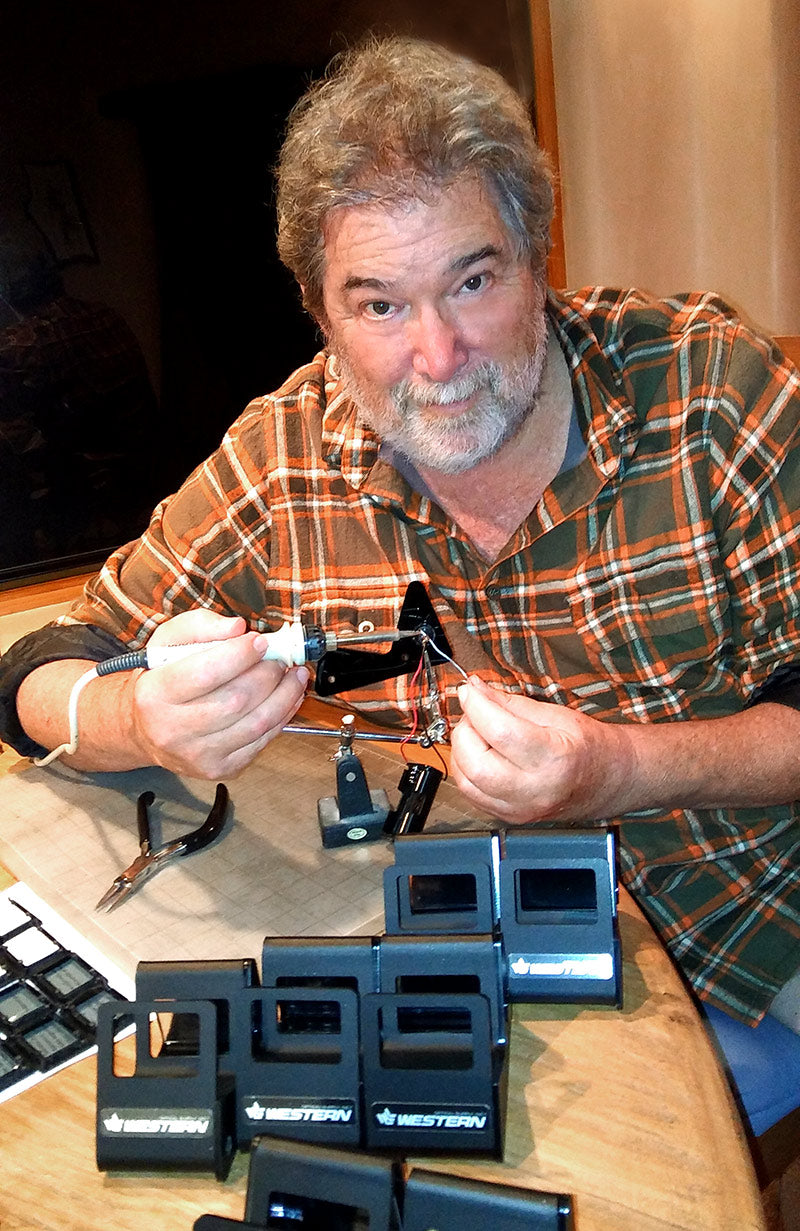
Joshua building Western's Polariscopes in 2018
In Junior High I had an afterschool job with the dress shop where my mother worked. I would be sent down to the garment district to pick up dresses and return them to the store. It was always an adventure. The garment district was a beehive of activity. I would make my way through the streets, crowded with workers pushing racks of clothing. Every level of those buildings was in fact a different factory. I loved when the freight elevator was full and had to stop on nearly every floor. The elevator doors would open and I could see an endless variety of goods being processed. Second floor could be a printing plant, third floor a button factory, the next an injection molding facility, the next metal working, etc. until I got to the garment factory floor where I would pickup the dresses.
Back then, many entry level jobs required training via the apprentice system, so to see a fourteen year old boy on a shop floor didn't attract attention. For a New York City kid it was a world of exciting possibilities where manufacturing was as natural a vocation as growing crops was to a farmer's child.
The other world I got to glimpse was on the east side of Central Park. Often after the alterations were done, my job would be to deliver the garments to residences on Fifth, Madison, Lexington and Park Avenues. I would take the subway down to the Natural History Museum stop on the west side and walk across Central Park to save the ten cent bus fare. (I'd walk both ways so that was an extra twenty cents!) Since I was delivering to women who knew my mom, I was usually invited up to the apartment or penthouse for milk and cookies. There I sat at the dining room table with the wife of some captain of industry. I vividly recall the amazing views of the city, the spaciousness of the residences and most of all the amazing artwork covering the walls. Original Monets, Chagalls, Picassos actually in someone's home!
As a kid, I was always admonished to "Ask good questions" so I did. "How do you get to live in a penthouse?" "How do you get to own a Rembrandt?" The replies all had fairly the same theme, "My husband was a child like you from a family like yours. He went to college, got a job, worked long and hard". OK, message received.
By the mid 1960s, Washington Heights was in transition. Many immigrant families from my parents' wave had succeeded enough to be able to move out of Manhattan and new groups were changing the feel of the neighborhood. Then, in my second year of George Washington High School, we moved to Los Angeles. It just took a few minutes driving away from LAX along the Pacific Coast Highway to realize that I had died and gone to heaven: the sunshine, the beaches, the girls!
The plan was to go to a University of California campus and study to be a doctor or lawyer. Since my parents were decidedly lower middle class, I had to work after school to earn and save money for college. I had a string of wonderful jobs working for entrepreneurial people. When I got to UCLA, I had enough work experience to get a great job in the medical center as a lab tech. I was trusted with keys to the lab so I could make my own hours. It was normal for me to complete classes and homework, then go to the lab at 2am to work before heading off to class again. It was grueling but I was able to get my BS in three years. By this time, I was eager to go out into the real world and not go for a higher degree.
Six months before graduating, I knew I was going to grab my diploma and run. I took a second position based solely on the job's location between my apartment and campus. It was as a part-time shipping clerk at Novamatic Systems. Now, if you don't recognize the name I understand but it makes me a little sad. Their claim to fame was being the sole importer from Japan of the first semi-automatic pattern blank maker. (What's a pattern maker? The pattern maker was a machine that traced the shape of the inside of the eyewear while punching out a duplicate from a thin plastic blank. The pattern was then mounted to an edger, back then using mostly ceramic wheels, and a glass lens was cut to duplicate the shape. It was revolutionary and yes, I go back that far.)
Meanwhile, in New York State, a gentleman by the name of Emil Santinelli was developing a lens edger that used a diamond impregnated cutting wheel to replace the ceramic stone. His company was named, Lemay Corporation. Novamatic Systems was also a distributor for Lemay Corporation which is how I got to meet and work with Mr. Santinelli.
After less than two years, I was hired by Lemay Corporation to head their California sales office and be responsible for overall marketing. It was another great job and by this time my feet had been firmly planted in the industry. My experience working with doctors at UCLA made me very comfortable communicating with ECPs and my respect for professionals naturally carried forward.
(Hang in there. Almost done.)
As marketing director at Lemay, I interacted closely with our distributors. One distributor was AEO Optical out of Norristown, Pa. The owners were Bob Getz (later of Topcon) and Alan Elgart. I vividly remember Alan telling me that I should supplement the sales of edgers by selling hand tools. He pulled out a Sadler Brothers Optical Tools catalog from his desk and handed it to me. It was small, blue in color with few pages but when I opened it, I was smitten. I was intrigued with the concept of there being highly specialized tools for doing very specific tasks.
My office, Lemay Corporation of California, became stocking distributors of Sadler Optical Tools. Our market penetration on the West Coast was gaining momentum as very few competitors stocked hand tools so our business grew quickly. Frequently we would find ourselves out of stock and having to wait for Sadler to get more inventory which put me in an uncomfortable position.
Around this time Emil Santinelli decided it was time to retire and Lemay Corporation went into the history books. I then founded Western Optical Supply, Inc. There is a whole bunch of history from previous president's messages (above) that you can "enjoy" but for now I am sticking to the tale of hand tools.

Sadler's tool shortages started to become extremely problematic. In addition, there were modifications to existing tools that I wanted to make along with entirely new designs. In the early 1970s, all optical pliers were made in one town by one small firm in Germany. I went over to Germany to track down the manufacturer to get them to produce a line of tools to my specifications. To my surprise, the tools were forged and finished in a factory space behind a private home which also served as the office. All around the shop floor were wooden crates holding pliers in various degrees of production. Written on the crates were: Hilsinger, Vigor, Sadler. Yikes! We were all selling the same plier from the same manufacturer. Well, that just wouldn't do.
On the other side of the planet, in another smaller town, dental hand tools were just beginning to be manufactured. Instead of firms handling production under one roof as in Germany, here production was farmed out to hundreds of cottage businesses all specializing in performing one or two fabrication functions. Coordinating all this and communicating with the customer was the "Jobber".
So in measured steps, our production started to shift from Germany to Pakistan. There were tremendous challenges for many years, including the language issue and cultural differences. This was around the time that the fax machine was introduced so communication was often sketchy. As there were no established lanes of commercial transportation, products were sent by postal service! Not fun.
However, (and you know there had to be a "however") the finished product was cosmetically very darn close to the German product. Though the plier looked good, there were all sorts of discouraging issues. As all control was in the hands of the Jobber, we couldn't verify the quality of the stainless steel. Specifications for the handle length and width were all over the place. The hole position for mounting the nylon jaws varied so much we couldn't sell our customers predrilled replacement pads. Plus a lot of promises were made and not kept which made inventory control problematic.
Out of this chaos came the decision that we needed to take charge of the manufacturing process. If Western Optical Supply controlled production, we would be assured of the quality of the steel used, manage fabrication so our inventory matched demand, have consistent higher quality product and be able to introduce new design innovations quickly.
Fortunately, I had struck up a personal relationship with a production floor manager at one of the Jobbers and reached out to him. That year we met at Silmo in Paris to work out an agreement whereby Western Optical Supply fronted the cost of a new factory. He agreed to maintain the highest production standards, to produce our innovations in secret and work with us in designing new hand tools. Our relationship has strengthened over the years since then and the intercourse remains exclusive.
That almost brings you up to date. Here and there throughout the website I'll post a short note about the story behind the product that I hope you will find interesting (it's the privilege of an "old timer"). It is my fervent hope that you will agree with and appreciate Western Optical Supply's driving philosophy and evolving history.

